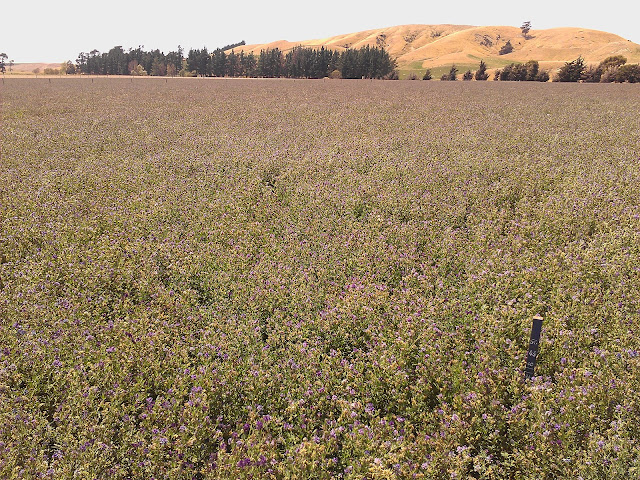Things are tracking along nicely for a good seed harvest at Jeffries Front Flat. The growth in this paddock is very impressive since my last visit in December. Please compare the pasture height photos below of the December visit (top) and the February visit (bottom). The time span between these 2 visits is 56 days, so with some rough (back of the envelope calculations) this crop has grown nearly a cm a day, has flowered and has also initiated seed set (all achieved during the middle of summer)! It is truly a remarkable plant.


Fraser and Doug are really pleased with the potential seed crop from this paddock, you can see the flowers that have already matured and developed seed in the photo above. This season’s weather conditions have been favourable for seed production in Lucerne:
Warm and sunny: important for plant growth, and improved flying and foraging conditions for bumble bees. Bumble bees are the principal pollinator of Lucerne at Bonavaree. Bumble bees will continue to fly and forage in cooler temperatures than honey bees, therefore the duration of foraging is extended when daytime temperatures are warm. Doug and Fraser recognise the extreme importance of protecting their bumble bee population and have implemented several techniques to support bee numbers throughout the year. We will cover more on bumble bee management at Bonavaree in a later blog.
Rain: there has been enough rain recently to produce sufficient dry matter, all which helps to initiate and support reproductive development.
Calm: important for bumble bees and consequent success of pollination. Bumble bees are not the most aerodynamic flyers, and therefore require relatively calm conditions to fly in.
Cool nights: are important for successful seed set.
The average plant height is ideal; there is sufficient leaf area there to capture enough light energy for flower and seed development. If the crop was to grow any higher, then the plant canopy is likely to collapse and lodge, this decreases the potential of the lower flowers to be pollinated and set seed, it can also cause issues come harvesting time.

Not all of the pure stands of Lucerne at Bonavaree are used for seed production, some are animals only, and none are used for cut and carry! Within these certified Torlesse paddocks there is equal emphasis on using the feed produced for feeding stock, as well as producing a great yield of seed per hectare in April/May . These crops are undoubtedly high production dual purpose plants that contribute a great deal to the bottom line.
